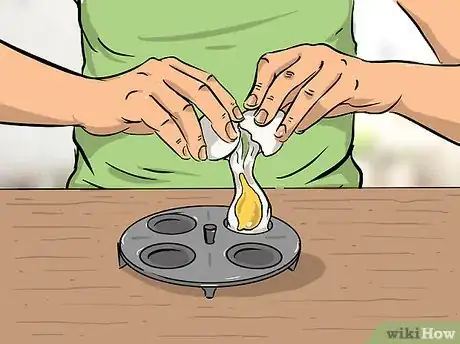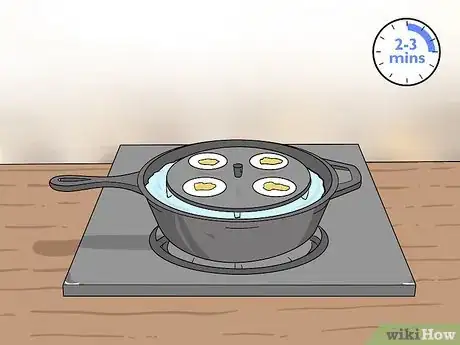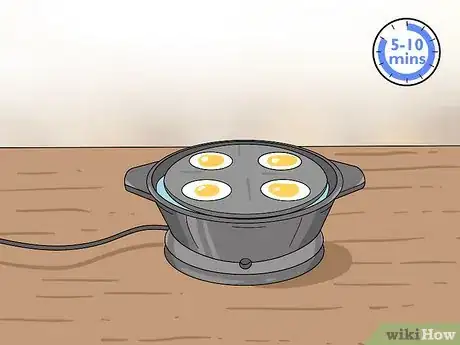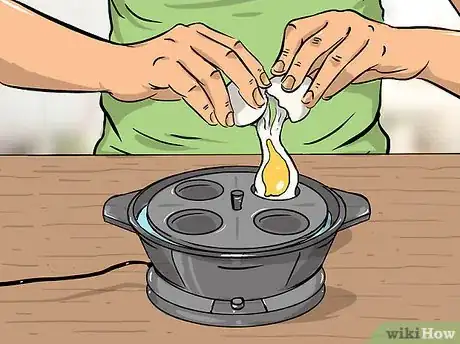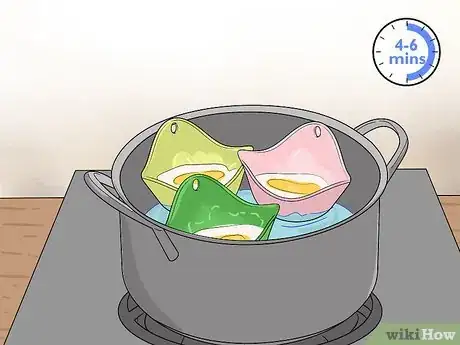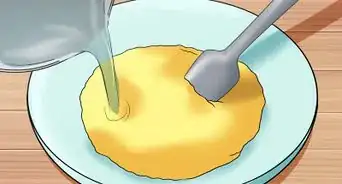This article was co-authored by wikiHow Staff. Our trained team of editors and researchers validate articles for accuracy and comprehensiveness. wikiHow's Content Management Team carefully monitors the work from our editorial staff to ensure that each article is backed by trusted research and meets our high quality standards.
There are 7 references cited in this article, which can be found at the bottom of the page.
This article has been viewed 372,439 times.
Learn more...
Egg poachers come in a variety of styles, including stove top pans, electric poachers, microwave poachers, and even silicone pods. Each type of poacher has different instructions for how to use it to poach an egg. Although this may sound a bit daunting, using an egg poacher is actually a lot simpler than you might think.
Steps
Using a Stovetop Poacher
-
1Bring a little less than 1⁄2 inch (1.3 cm) of water to a simmer in the pan. This should be enough water to touch the bottom of the cups when they're placed in the pan. Place the pan over medium or high heat on the stovetop to bring the water to a simmer.[1]
- Go with medium heat to best avoid a mess. If the water boils too vigorously, this may cause the egg whites to splash out and harden, creating a mess.
-
2Crack 1 egg into each individual poaching cup. To prevent the eggs from sticking, spray the cups with cooking oil before you add the eggs. You may need to crack each egg into a measuring cup first to make it easier to get into the poaching cup.[2]
- If you are not using all the cups, fill the extra cups with water to avoid any burning.
- Be sure you don't break the yolks when you pour the eggs into the cups.
Advertisement -
3Place the poaching cups into the pan and put the lid on top of them. Make sure the water in the pan touches the bottom of the cups when you put them in. The lid should be secure on top of the pan to prevent the steam heat from escaping.[3]
-
4Cook the eggs for at least 2-3 minutes, then take them out of the pan. Some people like to poach their eggs for as long as 5 minutes, but this ultimately depends on how runny you want the yolk to be. Use oven mitts to remove the pan from heat and empty the poaching cups into a separate bowl or plate.[4]
- You'll know the eggs are cooked when the outsides are pale white and the yolk is soft.
- The longer you cook the eggs, the firmer and less runny the yolk will be.
Using an Electric or Microwave Poacher
-
1Fill the poacher with water according to the manufacturer's instructions. Whether you're using an electric or microwave poacher, the amount of water you need to add will vary. Read the instructions carefully to know how much water you should add for the best poached eggs.[5]
- Microwave poachers often require about 1⁄2 teaspoon (2.5 mL) of water for each poaching cup.
-
2Heat up the poacher if you're using an electric cooker. Plug in the poacher and turn on the power to begin heating it up. It shouldn't take more than 5-10 minutes for the poacher to completely heat up.[6]
- If you're using a microwave poacher, you can skip this step.
- Many electric egg poachers come with special accessories for poaching since they're also capable of cooking hard-boiled eggs. Check to see if yours has a poaching accessory that you can use.
-
3Coat the egg cups with cooking spray, then break 1 egg into each cup. Apply a thin coat of cooking spray to the cups to prevent the poached eggs from sticking. Then, break each egg into a bowl, and then pour the egg into an egg cup.[7]
- Pour a small amount of water into any cups you're not using.
-
4Pierce each egg yolk with a fork if you're using a microwave poacher. Microwave temperatures will explode the yolk if it's not pierced. For best results, don't pierce the eggs more than once.[8]
-
5Cook the eggs in 30-second intervals if you're using a microwave. Pour a small amount of water on top of each egg, then close the lid on your poacher and place it in the microwave. Run the microwave on high for 30 seconds, then check to see if the eggs are done. If they aren't, cook them for another 30 seconds and check again.[9]
- Repeat this process of cooking in 30-second intervals until the eggs are white and the yolks are soft.
- This whole process should probably take you around 3-4 minutes, depending on how thoroughly you want the eggs to be cooked.
-
6Cook the eggs for about 6 minutes if you're using an electric cooker. Close the lid on your cooker and set a timer for 6 minutes. If the machine has its own timer, you can also use that instead.[10]
- The eggs will be poached when the timer goes off.
Using a Silicone Egg Pod
-
1Coat the inside of the pod with oil to keep the egg from sticking. Use cooking spray or a paper towel dipped in oil to coat the inside of the pod. If you want to give your egg a little extra flavor, you can also coat the pod with a thin layer of butter.[11]
- Note that this is not technically required in order to use the egg pod; it's simply recommended.
-
2Boil about 1⁄2 inch (1.3 cm) of water in a pot with a lid. Pour this much water into a pot and place the pot over medium heat on the stove. It should take about 5 minutes or so for the water to come to a boil.[12]
- The lid doesn't have to be on the pot while you're bringing the water to a boil. You just need to make sure you have a lid you can put on the pot later on.
-
3Crack the egg in the silicone pod and place the pod in the pot. Make sure you don't crack the egg's yolk when you break it into the pod. Place the flat side of the pod just on top of the water so that it floats on the surface.[13]
- Try to avoid getting any water inside the pod when you place it in the pot. Your egg won't be ruined if water gets inside the pod, but it may not come out as nicely.
-
4Cook the egg for 4-6 minutes, then remove the pod from the water. Use a ladle or wooden tongs to easily remove the pod. You may need to cook the egg for closer to 7 minutes, depending on how firm you want the yolk to be.[14]
- If you have trouble taking the egg out of the pod, run a spoon around the edges and pop the egg out.
- Poached eggs tend to get a rubbery texture if they’re left to sit for too long, so serve them as soon as they’re ready.
Our Most Loved Articles & Quizzes
Community Q&A
-
QuestionMy poached eggs always stick in my stove poacher. What am I doing wrong?
 Community AnswerPrior to cooking, spray the cups with a small amount of olive oil; this is best done using an olive oil spray bottle that mists the oil. This will allow the eggs to come loose freely after cooking. Butter can also be used, again in small amounts.
Community AnswerPrior to cooking, spray the cups with a small amount of olive oil; this is best done using an olive oil spray bottle that mists the oil. This will allow the eggs to come loose freely after cooking. Butter can also be used, again in small amounts. -
QuestionHow do I make a cheese omelette?
 Community AnswerMix eggs in a bowl and heat a pan with some butter/oil in it. Pour the eggs into the pan and let it cook for about a minute. Put cheese in the middle and flip one side of the eggs over the cheese. Wait another minute or so for the cheese to melt and remove the omelette from the pan.
Community AnswerMix eggs in a bowl and heat a pan with some butter/oil in it. Pour the eggs into the pan and let it cook for about a minute. Put cheese in the middle and flip one side of the eggs over the cheese. Wait another minute or so for the cheese to melt and remove the omelette from the pan.
References
- ↑ https://www.businessinsider.com/how-do-you-poach-an-egg#how-to-poach-an-egg-with-an-egg-poacher-3
- ↑ https://www.businessinsider.com/how-do-you-poach-an-egg#how-to-poach-an-egg-with-an-egg-poacher-3
- ↑ https://www.youtube.com/watch?v=Bmib7WHV_0w#t=20s
- ↑ https://www.youtube.com/watch?v=Bmib7WHV_0w#t=1m28s
- ↑ https://www.businessinsider.com/how-do-you-poach-an-egg#how-to-poach-eggs-without-a-stove-or-microwave-4
- ↑ https://www.businessinsider.com/how-do-you-poach-an-egg#how-to-poach-eggs-without-a-stove-or-microwave-4
- ↑ https://www.businessinsider.com/how-do-you-poach-an-egg#how-to-poach-eggs-without-a-stove-or-microwave-4
- ↑ https://www.melaniecooks.com/how-to-cook-eggs-in-a-microwave-egg-poacher/960/
- ↑ https://www.melaniecooks.com/how-to-cook-eggs-in-a-microwave-egg-poacher/960/
- ↑ https://www.businessinsider.com/how-do-you-poach-an-egg#how-to-poach-eggs-without-a-stove-or-microwave-4
- ↑ https://www.telegraph.co.uk/foodanddrink/recipes/11091677/How-to-cook-the-perfect-poached-egg.html
- ↑ https://www.telegraph.co.uk/foodanddrink/recipes/11091677/How-to-cook-the-perfect-poached-egg.html
- ↑ https://www.thekitchn.com/silicone-egg-po-17050
- ↑ https://www.thekitchn.com/silicone-egg-po-17050
About This Article
To use a stovetop egg poacher, start by filling the bottom of the poaching pan with enough water to touch the bottom of the egg cups when they’re placed in the pan. Next, spray the individual cups with nonstick cooking spray and crack an egg into each one. If you're not using all the cups, fill the extra cups with water to prevent burning. Bring the water to a boil over medium-high heat, cover the poacher with a lid, and cook the eggs for 2-3 minutes until they look opaque and white. Finally, remove the lid and take the eggs out of the cups to serve them. For tips on how to poach eggs in the microwave, read on!

